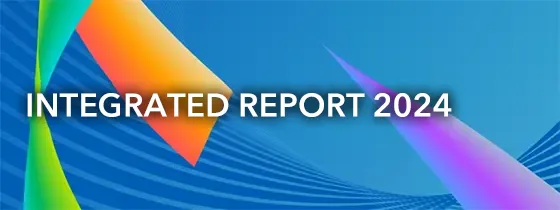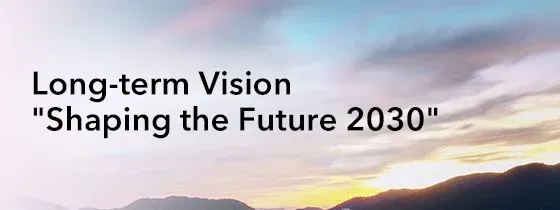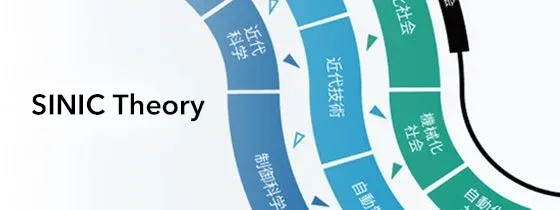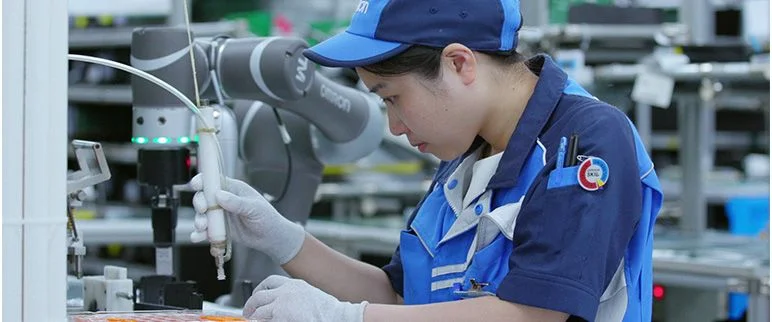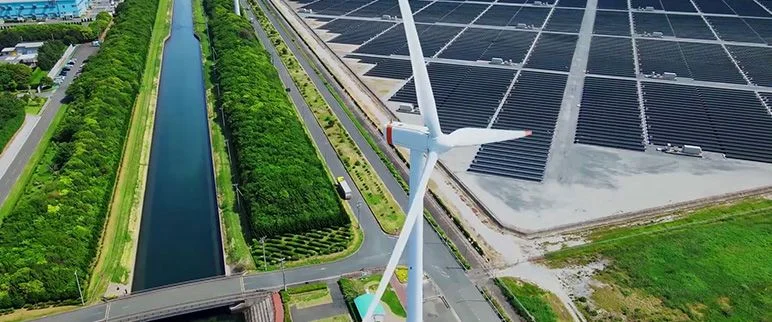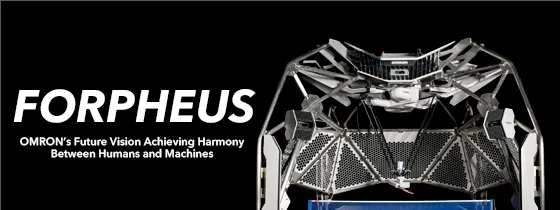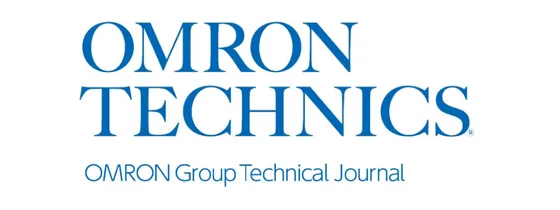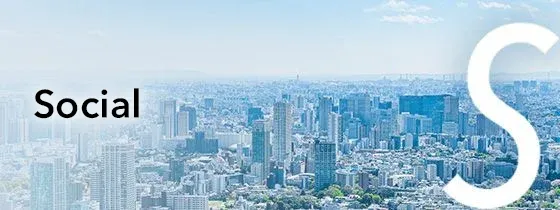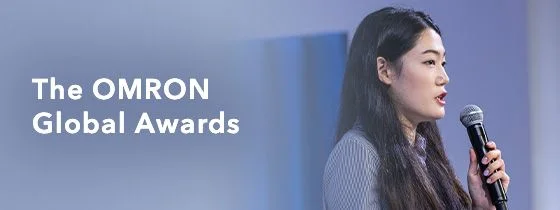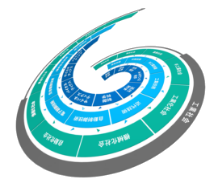 SINIC Theory:
SINIC Theory:
A Compass for the Future

Informed by OMRONŌĆÖs mission of contributing to a better society, the SINIC theory grew from the idea that in order to manage a business by anticipating social needs, it is necessary to predict what society will look like in the future. Based on this theory, OMRON has been able to continually make social proposals marked by foresight. But what exactly is this SINIC theory that enables it to still serve as a compass for guiding OMRONŌĆÖs management?
The SINIC theory is a future prediction method that OMRON founder Kazuma Tateishi and his collaborators developed and presented at the International Future Research Conference in 1970. Tateishi believed that in order to solve social issues through business and create a better society, it would be essential to create social needs ahead of other actors in society. Believing that this would, in turn, require a compass to navigate the future, Tateishi pursued futurology research and constructed the SINIC theory himself. Announced in the midst of Japan's rapid-paced economic growth, before PCs and the Internet even existed, this theory predicted the appearance of the Information Society, which was in the near future at the time of the theoryŌĆÖs announcement, and drew a picture of society up to the middle of the 21st century.
SINIC stands for Seed-Innovation and Need-Impetus Cyclic Evolution. The basic idea behind the theory is that society evolves as science, technology, and society interact with one another. Science provides the seeds for technology, and technology enables changes in society; at the same time, society generates needs for technology, and technology stimulates scientific endeavor. The SINIC theory expresses the basic structure through which this mutual interaction across the three realms of science, technology and society and humansŌĆÖ coexistence-oriented motivation become the driving force for accelerating social evolution in a circular pattern. Other features of this future predictive theory include the circular configuration of value outlooks, and the curve of maturation in the development process.
Tracing the Big History of Science, Technology and Society through to the Present Day
The SINIC theory does not jump straight into future prediction: it begins by surveying the major currents of human history and asking: What can we learn about the development of science, technology, and society by taking a birdŌĆÖs eye view of the history of humankind as a whole?
Human history began more than 1 million years ago with the emergence of primitive humans. A growing emphasis on the ŌĆ£groupŌĆØ drove human evolution from Primitive Society to Collective Society. The Agricultural Society followed, with a new focus on tools, crops, and other physical objects. This formed the basis for the Industrialized Society which began in the 14th century AD. The SINIC theory divides this Industrialized Society into five developmental phases: first, there was a shift from a Handicraft Society to an Industrialization Society under modern capitalism; then, 1870 saw the advent of a Mechanization Society; an Automation Society developed in the 20th century; and from the end of the 20th century until the dawn of the 21st century was an Information Society.
The 20th century was a time of particularly rapid transition through three kinds of industrialization: the Mechanization Society, the Automation Society and the Information Society. As a result of this transition, humankind obtained wealth in a material sense, as well as shifting to a society focused on the ŌĆ£individual.ŌĆØ It is in this society that technology and science have evolved through cross-influence, as seen in how control science and cybernetics have seeded OMRONŌĆÖs current core control technology. The Automation Society centered on manufacturing and information processing came about just as predicted by the SINIC Theory.
With this broad view of human history, it becomes clear that science, technology, and society are constantly evolving toward the creation of a ŌĆ£better society,ŌĆØ along with important developments in the values that society holds. Values have shifted from the ŌĆ£spiritualŌĆØ to the ŌĆ£materialŌĆØ and from the ŌĆ£collectiveŌĆØ to the ŌĆ£individual.ŌĆØ What values will be emphasized in the future, beyond the ŌĆ£materialŌĆØ? And what will supplant our current focus on the ŌĆ£individualŌĆØ? These are important questions when seeking to predict the future. Rather than envisioning the emergence of new values, the SINIC Theory holds that societyŌĆÖs focal values evolve in a circular pattern. This forms the basis of the theoryŌĆÖs normative view of the future, encompassing both future possibilities and future aspirations.
Optimizing Society: The Present Phase in the SINIC Theory
Following the Information Society, which was an Automation Society driven by the information technologies of computerization and systematization, came the Optimizing Society, running from 2005 to 2024. This is by no means an ŌĆ£optimalŌĆØ society: it is a society of ongoing optimization, predicted to be an era of great change as we move toward the Autonomous Society beginning in 2025, which marks a significant turning point. The world today is truly in the midst of the conflict and confusion of the Optimizing Society. We continue to see the outbreak of wars and disputes despite the expectation that they would disappear; infectious diseases are spreading unexpectedly; climate change is triggering large-scale environmental disasters; the economic system based on mass production and mass consumption is reaching its limits; the advancement of AI technology is occasioning an employment crisis. As a result, there is widespread uncertainty and pessimism regarding the future.
Humankind has acquired material wealth, but also left many problems unsolved in areas such as energy, resources, food supply, and human rights. Resolving the negative legacies accumulated during the Industrial Society period is one of the major themes in the Optimizing Society. Worldwide initiatives toward the 17 Sustainable Development Goals (SDGs) is a key movement in the Optimizing Society. Companies and other organizations are starting to take serious action, aspiring to solve social issues through their own activities.
Solving outstanding issues from the past is not the only theme, however. It is equally important to prepare for the future so we can achieve a soft landing in the forthcoming Autonomous Society. A key theme here is to cultivate predictors of a society that creates values on a larger scale, pursuing ŌĆ£spiritualŌĆØ wealth such as the joy of living, and fostering complementarity and mutual support among autonomous ŌĆ£individuals.ŌĆØ
The Optimizing Society is a significant paradigm shift even in the broader context of human history, so the SINIC Theory underlines the need for humans to change themselves as well. Considerable difficulties will accompany the transformation into autonomous human beings. The theory acknowledges that there is potential for people to be left behind, unable to achieve this transformation, and that such an outcome would make the transition to Autonomous Society more difficult. The theory also sounds a warning on the weakening of humankind, which has progressed imperceptibly through trends such as specialization and the pursuit of convenience and comfort. Put another way, in order to build a better society, it is important not only to pursue the SDGs, but also to foster the Autonomous Society.
Autonomous Society: The Near Future
In the context described above, the SINIC Theory identifies three elements that constitute the Autonomous Society: Independence (standing on oneŌĆÖs own), Connectivity (engaging with others), and Creativity (producing new things). It is at the point of overlap between these elements that future potentials for the Autonomous Society are generated. This idea connects with philosopher Ivan IllichŌĆÖs concept of a ŌĆ£convivialŌĆØ society marked by self-reliance, coexistence, and mutual enjoyment.
This society will be one in which individuals can live in the manner they choose, harmonize with the rest of society, and contribute to the creation of new values for social betterment. This may sound like an idealistic vision of a social utopia. But advancements in science and technology have the potential to make it a reality. The real question is how to design science and technology in a way that satisfies social needs in the Autonomous Society.
Addressing this question will likely lead to the establishment of a new field of ŌĆ£psycho-physical technologyŌĆØ that is more concerned with humansŌĆÖ inner world, spirituality, and emotions. In this context, it will also be important to shape science and technology from an ŌĆ£ethicalŌĆØ standpoint, rather than the conventional approach whereby individuals and society simply adapt to new technologies. In all sorts of areas, including AI, genetic medicine, mobility, monetary systems, manufacturing, residential environments, work styles, leisure, art, and sports, we will see an emergence of forms of co-creation and innovation that are characterized by autonomy and improved sustainability.
This means that OMRON, which uses the SINIC Theory as its compass for management, will develop technologies that integrate the realms of ŌĆ£individual and society,ŌĆØ ŌĆ£humans and nature,ŌĆØ and ŌĆ£humans and machines,ŌĆØ while dynamically maintaining an optimal balance among them. OMRON will thereby contribute to a better society and a future marked by autonomy and diversification.
Achieving the Autonomous Society through Empathy and Co-creation
As progress in science and technology and social change continue to accelerate in the near future, it will be increasingly difficult for any single company or organization to achieve a better society on its own. It will be important to pursue a co-creation model in which multiple companies, each independent, work in partnership to create change.
An important element of co-creation is a vision for the future, which is the core that all partners in co-creation can connect and empathize with. OMRON has resolved to make the future outlooks generated by SINIC Theory openly available in order to expand the circle of empathy and promote co-creation. We also believe that the economic system of the Autonomous Society can achieve a major paradigm shift from money capitalism to empathy capitalism. Building empathy may take far more time and effort than is required to perform monetary transactions, but we are convinced that sparing no effort in this regard is the key to creating a better future.
Looking Further Ahead to the Natural Society
Under the SINIC Theory, the first phase of human history, which began with the Primitive Society, will come to an end when the Autonomous Society is fully established. The theory predicts that the second phase will start in 2033 with the advent of the Natural Society. This does not signify a return to the Primitive Society of the past. Instead, like ascending a spiral staircase along the surface of a cone, it will mark the start of what could alternatively be called a Hyper-Primitive Society, a higher plane of development than the original Primitive Society.
OMRONŌĆÖs think tank, the Human Renaissance Institute, is already initiating discussions to envision this Hyper-Primitive Society with thinkers both within Japan and internationally. Rather than situating human society in binary opposition to the natural world, these discussions are directed toward a world in its natural state, with humans and technology both forming part of nature and constituting a sustainable, enriched society. A pathway is thus being laid toward realization of the concept of ŌĆ£no controlŌĆØ that the SINIC Theory posits as the ideal for society.
As OMRON works to build a better society, we are committed to making the SINIC TheoryŌĆÖs future outlooks openly available, pursuing co-creation with many different companies, organizations, and individuals, and thereby expanding the circle of empathy and co-creation for a better future.

